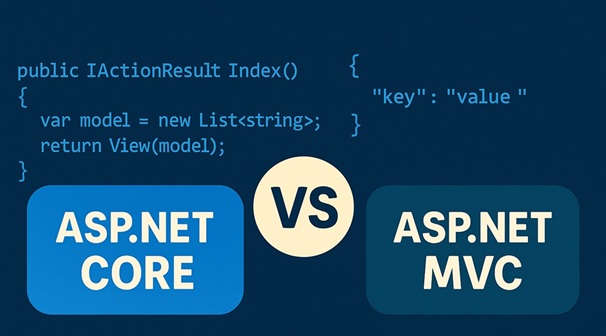The Language Behind the Product: Why It Still Matters
In 2025, the conversation around programming languages has matured. It’s no longer about what’s “popular” on GitHub - it’s about what sustains long-term scalability, cloud readiness, and developer efficiency.
At TwinCore, we’ve seen firsthand how the right language choice shapes an entire project’s lifecycle - from architecture and performance to hiring and maintainability. A logistics platform or ERP system written in a mature, strongly-typed environment behaves very differently from one built on fast-moving frameworks with weak type safety.
Below we’ll explore the ten languages that power TwinCore’s engineering stack, why we rely on them, and how they help our clients build resilient, enterprise-grade systems.
1. C#: The Foundation of Enterprise-Grade Systems
C# remains the backbone of our architecture. It’s not just a Microsoft legacy - it’s an engineering ecosystem that continues to evolve with .NET Core, Blazor, and cloud-native development.
At TwinCore, C# drives our Transport Management Systems (TMS), ERP modules, and B2B portals. Its strong typing, asynchronous processing model (async/await), and integrated dependency injection make it ideal for scalable backends and service-based architectures.
We prefer C# because it allows us to write once and deploy anywhere: Linux servers, Windows environments, or Azure Cloud. Combined with Blazor, it lets us build full-stack web apps where front-end and back-end share the same language and even the same data models - dramatically reducing cognitive load across teams.
Simply put, C# is our language of trust when the system must stay online 24/7 and handle millions of operations without losing precision.
2. TypeScript: Safety and Consistency on the Front Line
TypeScript changed how modern web development feels at scale. At TwinCore, we treat TypeScript not as “JavaScript with types,” but as the front-end equivalent of C# - a language that introduces structure and discipline to large-scale UI projects.
Our front-end teams use TypeScript with Angular and React to build complex dashboards, dispatch panels, and admin interfaces for logistics and SaaS clients. Its static type checking eliminates many runtime surprises, especially when APIs evolve.
In enterprise projects, multiple developers often work on the same UI layer. TypeScript ensures that each component communicates through predictable interfaces - and when backend contracts change, the compiler, not the customer, tells us first.
That’s why we don’t just use TypeScript for the sake of trendiness - we use it because it makes multi-team collaboration sustainable.
3. JavaScript: The Universal Glue Between Systems
Even with TypeScript leading the modern stack, JavaScript remains irreplaceable. It’s still the most universal connector in our ecosystem.
In TwinCore projects, we use JavaScript for tasks that require dynamic interaction with third-party SDKs, embedded analytics tools, or map integrations. Whether it’s integrating Google Maps APIs into logistics dashboards or embedding real-time telematics data into customer portals, JavaScript serves as the bridge between frameworks and external systems.
It’s also essential when maintaining older enterprise software - jQuery and vanilla JS still appear in legacy modules that we gradually modernize to Angular or Blazor. Our goal is never to “kill” JavaScript, but to make it coexist within a modernized, type-safe environment.
4. SQL: The Invisible Engine Behind Every Report
Every scalable system eventually comes down to how fast it can retrieve and process data. SQL - whether it’s Microsoft SQL Server, PostgreSQL, or MySQL - remains the backbone of our data-driven projects.
At TwinCore, we invest heavily in query optimization, index tuning, and schema design. A well-written query can improve report speed fivefold without touching a single line of C# code.
In logistics and ERP systems, efficient SQL isn’t just a technical matter - it’s a business advantage. A billing dashboard that loads in 1 second instead of 8 improves user retention and perceived reliability.
That’s why we still treat SQL as a full-fledged language in our stack - because it defines how information flows through the product.
Our rule of thumb: frameworks change, but SQL performance always compounds.
5. Kotlin: The Modern Successor to Java in Scalable Development
Kotlin represents the evolution of the Java ecosystem - a language designed to bring safety, conciseness, and modern thinking into enterprise development.
At TwinCore, we use Kotlin for projects that require robust backend performance with a cleaner, more expressive syntax than Java. Its null-safety, coroutines, and seamless JVM interoperability make it perfect for scalable APIs, microservices, and Android applications.
In logistics and SaaS environments, Kotlin often acts as a middle ground between the structure of .NET and the flexibility of JavaScript-based stacks.
It helps us build services that are both strongly typed and developer-friendly, reducing boilerplate while maintaining enterprise-grade reliability.
Because Kotlin compiles to JVM bytecode, it integrates easily with existing Java-based systems. We often introduce it into legacy infrastructures as a gradual modernization step - adding new microservices or replacing high-maintenance modules without rewriting the entire platform.
6. Python: The Bridge Between Data, AI, and .NET
While .NET covers most of our business logic, Python fills the analytical gap. Its strength lies in data transformation, automation, and AI prototyping.
At TwinCore, Python is used to build side modules that connect to .NET systems:
- Predictive models for route optimization.
- ETL scripts that clean and transform logistics data.
- Lightweight APIs built with FastAPI to expose analytics endpoints.
Python’s ecosystem - pandas, NumPy, scikit-learn - allows our data engineers to experiment fast, then integrate insights back into the main application.
The value is not in Python alone, but in how it complements .NET. Together they form a bi-lingual architecture: structured on the outside, intelligent on the inside.
7. Go (Golang): Small, Fast, and Exceptionally Reliable
When performance and simplicity matter, Go is our go-to language for microservices and cloud connectors.
We use Go in projects that demand lightweight containers and predictable concurrency - typically for API gateways, real-time notifications, or internal DevOps tooling.
Its built-in concurrency model (goroutines, channels) allows us to handle thousands of simultaneous operations with minimal overhead. Go binaries are compact, deploy instantly, and fit perfectly into cloud-native environments such as Azure Kubernetes Service.
Unlike some “academic” languages, Go is pragmatic - it does one thing extremely well: speed with reliability. That’s why TwinCore teams often build auxiliary services in Go while keeping business logic in C#.
8. PowerShell & Bash: Automation as a Cultural Principle
At TwinCore, automation isn’t a DevOps afterthought - it’s a cultural norm.
PowerShell scripts manage everything from SSL renewals and Azure deployments to CI/CD triggers. Bash scripts handle container orchestration and Linux-based automation.
Our developers maintain their own deployment scripts, ensuring that the gap between “dev” and “ops” stays minimal. It also means that repetitive actions - spinning up a new Blazor environment or refreshing test data - take seconds, not hours.
Languages like PowerShell and Bash may not get the same spotlight as Python or C#, but they’re what keeps production clean and reproducible. They represent discipline through automation, and that’s at the core of every TwinCore delivery pipeline.
9. Rust: Precision Where Performance Meets Safety
For highly specialized modules - encryption, telemetry, or low-level parsing - we sometimes turn to Rust.
Its strict compiler rules prevent memory leaks, race conditions, and unsafe references - common sources of downtime in mission-critical systems.
Rust isn’t our everyday tool, but when precision matters more than convenience, it’s unmatched. Think of Rust as our “performance scalpel”: used sparingly, but always for the most delicate work.
The combination of .NET stability with Rust’s system-level safety gives our solutions the best of both worlds - enterprise reliability and near-native speed.
10. F#: The Functional Edge of the .NET Ecosystem
While C# remains our primary engine for backend logic, F# plays a unique and strategic role in TwinCore’s development environment. It represents the functional mindset within the .NET world - expressive, concise, and mathematically precise.
F# shines in scenarios where reliability and data transformation dominate. It’s particularly effective for:
- Complex data pipelines that require immutability and strict type inference.
- Predictive analytics or optimization logic where deterministic outcomes matter.
- Rule-based systems, simulation models, and risk analysis engines.
Because it compiles seamlessly into .NET assemblies, F# integrates naturally with the same infrastructure we use for C# - sharing models, APIs, and deployment pipelines.
At TwinCore, we use F# selectively in projects that involve logistics optimization, financial modeling, or algorithmic decision modules - the kind of systems where correctness outweighs convenience.
11. PHP: The Veteran That Still Delivers
While PHP no longer dominates headlines, it remains one of the most practical languages for rapid web development - and still powers much of the internet. At TwinCore, we use PHP selectively for legacy integrations, CMS extensions, and lightweight web applications that demand quick turnaround with minimal infrastructure overhead.
Modern PHP frameworks like Laravel and Symfony bring structure, dependency injection, and ORM efficiency comparable to .NET or Node.js environments. In cases where clients already maintain a PHP-based ecosystem (for example, WordPress portals or internal dashboards), our engineers upgrade codebases to modern standards instead of rewriting them from scratch.
This approach keeps delivery fast, secure, and cost-effective - while maintaining compatibility with the client’s existing hosting stack. PHP might be a veteran, but when it’s well-architected, it still delivers enterprise-grade stability.
12. Java: The Pillar of Enterprise Integration
Java remains the language of choice for financial, telecom, and enterprise middleware - domains where stability, security, and interoperability outweigh experimentation. At TwinCore, we use Java primarily for projects requiring deep integration with existing corporate infrastructure, such as message brokers, ERP systems, or authentication servers.
Its JVM ecosystem offers unmatched scalability: Spring Boot for APIs, Kafka for event streaming, and Hibernate for data abstraction. When clients already operate large Java environments, our teams extend those systems rather than replace them - connecting C# or Python microservices through REST, GraphQL, or gRPC gateways.
The result: modernization without fragmentation. Java represents the steady heartbeat behind many large-scale systems we help evolve rather than reinvent.
13. Ruby: Rapid Prototyping with Elegant Discipline
Ruby, particularly through Ruby on Rails, remains one of the fastest ways to prototype and validate business ideas. At TwinCore, we use Ruby for MVPs, internal tools, and proof-of-concepts - situations where clarity of syntax and developer velocity are more valuable than raw performance.
Ruby’s conventions enforce clean architecture by default. Its emphasis on “developer happiness” aligns perfectly with our agile culture: quick iteration, expressive code, and maintainable structure. Even after deployment, Ruby apps are easy to extend or migrate into more rigid ecosystems like .NET or Java once the concept matures.
For clients testing new digital products, Ruby offers something few languages can: speed without chaos. It’s our sandbox for ideas that often grow into full-fledged enterprise solutions later on.
14. Swift: Precision for Mobile-First Experiences
Swift has transformed mobile development by bringing performance, safety, and clarity to the Apple ecosystem. At TwinCore, we use Swift for native iOS applications that require flawless UX and tight integration with existing enterprise APIs.
Its strong typing and compile-time safety mirror our backend standards - reducing runtime crashes and ensuring consistent user experiences. SwiftUI and Combine make reactive UI development predictable and testable, while seamless CI/CD integration with Xcode pipelines lets us maintain continuous delivery for mobile projects.
Whether it’s a logistics tracking app, customer dashboard, or healthcare assistant, Swift ensures every interaction feels fluid, native, and enterprise-ready - extending TwinCore’s engineering quality to the user’s pocket.
15. R: The Specialist in Statistical Insight
R may not run production servers, but it shines where data interpretation and forecasting define business decisions. Our data analysts and engineers use R alongside Python to build statistical models, visualizations, and experimental reports that guide logistics optimization and financial analysis.
While Python dominates machine learning, R remains unmatched for exploratory data analysis (EDA) and advanced statistical modeling - especially when verifying predictive accuracy or visualizing complex datasets. We often combine R’s analytical power with Python’s API exposure: R handles the research; Python operationalizes it into .NET-integrated endpoints.
At TwinCore, R represents precision science - the language we use when insight must be quantifiable, defensible, and data-driven.
A Multilingual Stack for a Unified Product Vision
Modern enterprise software rarely lives within a single programming language. What makes TwinCore’s stack resilient is how these languages interlock across different layers - each chosen for a clear reason, not by habit.
For example, a typical logistics or ERP system we build may include:
- C# and .NET for all business logic and API orchestration.
- TypeScript/Angular for the client dashboard, customer portals, and control panels.
- SQL and NoSQL for data persistence, analytics, and telemetry.
- Python for forecasting, predictive modeling, or AI modules.
- PowerShell/Bash to automate cloud deployments and monitoring.
By using each language where it performs best, we create what we call a distributed monolith - one cohesive architecture built from multiple specialized components that scale independently but operate as a single system.
C# and Blazor: Merging Frontend and Backend in One Mindset
Blazor has become one of the defining tools of our stack. For many clients, especially in logistics, healthcare, and construction, having a unified codebase is priceless.
By writing both client and server code in C#, we cut development time and reduce the risk of cross-language mismatches. Blazor WebAssembly delivers the same interactivity as Angular or React, yet allows reuse of .NET libraries and models across the entire solution.
In practice, this means one developer can work on both layers - updating business rules and front-end UI simultaneously - without waiting for API re-alignments.
This is one of TwinCore’s biggest strengths: teams that think full-stack in .NET, not just write it.
SQL and NoSQL: Where Reliability Meets Flexibility
Our database strategy is hybrid by design. SQL provides the transactional backbone - orders, invoices, customer accounts - while NoSQL adds elasticity for data that grows unpredictably, such as IoT signals, vehicle positions, or sensor data from the field.
For example:
- MS SQL handles structured financial records and reporting.
- PostgreSQL powers cross-regional APIs and analytics with its JSONB and GIS extensions.
- MongoDB / Cosmos DB stores real-time, high-velocity data streams.
This separation means each part of the system performs exactly where it should. Traditional relational databases ensure integrity; NoSQL databases enable scale. The result is a system that stays accurate under load and responsive under stress.
TypeScript, Angular, and React: UX That Mirrors Operational Reality
Logistics software has to be both technical and visual - dispatchers can’t interpret code; they rely on UI clarity.
That’s why TypeScript-based frameworks like Angular and React are our front-end standards. They allow us to build reactive interfaces that update instantly as new data arrives.
Angular powers enterprise dashboards and internal management panels, while React often serves customer-facing portals where we need flexibility and light footprint.
At TwinCore, every TypeScript application is designed with a principle: visual stability under pressure. Whether a user is tracking one truck or a hundred, the UI remains fast, structured, and predictable.
Python in the TwinCore Ecosystem: Turning Data Into Foresight
Python entered our stack naturally, as our logistics and SaaS clients started demanding analytics that go beyond reporting.
For example, in a recent project, we integrated a Python-based forecasting engine that predicts delivery delays based on historical route patterns and weather data. The model runs as a separate microservice, exposing results via an API consumed by the main .NET application.
This separation ensures scalability - Python handles computation-heavy workloads while C# remains focused on business logic and user workflows.
We also use Python for data cleaning, ETL, and dashboard preprocessing, letting our systems feed clean, structured information to end-users.
Go, PowerShell, and Bash: The Unsung Heroes of DevOps
Behind every smooth-running product lies automation. Our cloud and infrastructure teams rely on Go, PowerShell, and Bash to orchestrate complex pipelines.
- Go is used to build lightweight CLI tools and background services - API relays, webhook consumers, and monitoring agents.
- PowerShell automates Azure resource creation, certificate renewal, and permission management.
- Bash scripts handle container orchestration and log rotation for Linux-based environments.
These languages may not appear in marketing materials, but they’re what make our delivery pipelines reliable. We prefer automation over administration - it’s the mindset that keeps TwinCore fast, even as projects scale.
Integration Case: From SaaS Portal to In-House Platform
Many companies start with a SaaS solution - quick to adopt but restrictive as they grow. We often help clients transition toward in-house platforms by gradually introducing custom modules.
In one such case, a client running a third-party SaaS TMS wanted custom integration with their WMS and accounting system. Instead of a full rewrite, we extended the SaaS product through custom C# microservices communicating with the vendor’s API, and added a Blazor-based front-end for better UX.
Over time, this evolved into a full in-house system, leveraging the same languages - C#, TypeScript, SQL - but now with complete data control and zero vendor lock-in.
This phased evolution is exactly where TwinCore’s multilingual stack shines - incremental modernization without disruption.
The Cultural Impact of Language Diversity
Each programming language in our stack comes with its own philosophy:
- C# teaches structure and reliability.
- TypeScript enforces discipline on the front end.
- Python encourages exploration and iteration.
- Go inspires efficiency.
- SQL reminds us that everything ends in data integrity.
By combining these mindsets, we cultivate teams that are both creative and systematic. A TwinCore engineer isn’t “just a C# developer” - they’re problem solvers fluent in multiple technical dialects.
This language diversity is one of our strongest competitive advantages. It makes our systems cross-functional and our teams cross-capable.
Choosing Languages That Endure
Technology trends come and go, but the languages behind TwinCore projects share a common trait - longevity.
We don’t chase the newest syntax or the latest hype; we choose tools that deliver predictability, maintainability, and long-term ROI.
When a client entrusts us with building their logistics platform, SaaS portal, or enterprise software, they’re not just getting code - they’re getting a technology foundation built to last.
From C# to TypeScript, from SQL to Python, every choice in our stack serves one goal: enabling scalable, data-driven, and future-ready products.
At TwinCore, that’s not a theory - it’s how we build every day.

 LinkedIn
LinkedIn
 Twitter
Twitter
 Facebook
Facebook
 Youtube
Youtube






